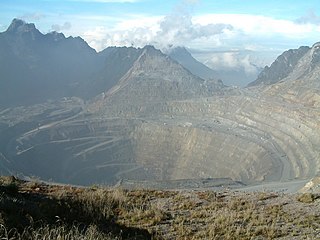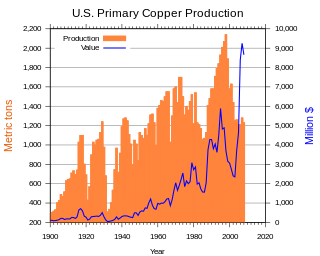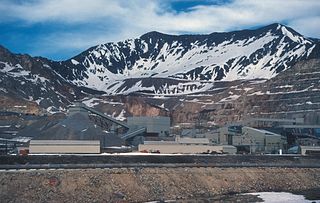Freeport-McMoRan Inc., often called Freeport, is an American mining company based in the Freeport-McMoRan Center, in Phoenix, Arizona. The company is the world's largest producer of molybdenum, a major copper producer and operates the world's largest gold mine, the Grasberg mine in Papua, Indonesia.
The Cyprus Mines Corporation was an early twentieth century American mining company based in Cyprus. In 1914, Charles G. Gunther began prospecting in the Skouriotissa area after reading in ancient books that the island was rich in copper and noticing promising ancient Roman slag heaps in the area. The company was established in 1916 by Colonel Seeley W. Mudd, his son, Harvey Seeley Mudd, and mining engineer/business partner, Philip Wiseman, whose family, along with the Mudds, were the primary owners of Cyprus Mines until the early 1970s when it was sold to Amoco.

Chuquicamata is the largest open pit copper mine in terms of excavated volume in the world. It is located in the north of Chile, just outside Calama, at 2,850 m (9,350 ft) above sea level. It is 215 km (134 mi) northeast of Antofagasta and 1,240 km (770 mi) north of the capital, Santiago. Flotation and smelting facilities were installed in 1952, and expansion of the refining facilities in 1968 made 500,000 tons annual copper production possible in the late 1970s. Previously part of Anaconda Copper, the mine is now owned and operated by Codelco, a Chilean state enterprise, since the Chilean nationalization of copper in the late 1960s and early 1970s. Its depth of 850 metres (2,790 ft) makes it the second deepest open-pit mine in the world, after Bingham Canyon Mine in Utah, United States.

Copper extraction refers to the methods used to obtain copper from its ores. The conversion of copper ores consists of a series of physical, chemical, and electrochemical processes. Methods have evolved and vary with country depending on the ore source, local environmental regulations, and other factors.

The National Copper Corporation of Chile, abbreviated as Codelco, is a Chilean state-owned copper mining company. It was formed in 1976 from foreign-owned copper companies that were nationalised in 1971.

The Grasberg mine has one of the largest reserves of gold and copper in the world. It is located in Mimika Regency, Central Papua, Indonesia near Puncak Jaya. It is operated by PT Freeport Indonesia, a joint venture among the government of Indonesia, government of Central Papua, and American company Freeport-McMoRan (FCX).

Porphyry copper deposits are copper ore bodies that are formed from hydrothermal fluids that originate from a voluminous magma chamber several kilometers below the deposit itself. Predating or associated with those fluids are vertical dikes of porphyritic intrusive rocks from which this deposit type derives its name. In later stages, circulating meteoric fluids may interact with the magmatic fluids. Successive envelopes of hydrothermal alteration typically enclose a core of disseminated ore minerals in often stockwork-forming hairline fractures and veins. Because of their large volume, porphyry orebodies can be economic from copper concentrations as low as 0.15% copper and can have economic amounts of by-products such as molybdenum, silver, and gold. In some mines, those metals are the main product.

In the United States, copper mining has been a major industry since the rise of the northern Michigan copper district in the 1840s. In 2017, the US produced 1.27 million metric tonnes of copper, worth $8 billion, making it the world's fourth largest copper producer, after Chile, China, and Peru. Copper was produced from 23 mines in the US. Top copper producing states in 2014 were Arizona, Utah, New Mexico, Nevada, and Montana. Minor production also came from Idaho and Missouri. As of 2014, the US had 45 million tonnes of known remaining reserves of copper, the fifth largest known copper reserves in the world, after Chile, Australia, Peru, and Mexico.
Lundin Mining Corporation is a Canadian company that owns and operates mines in Sweden, United States, Chile, Portugal and Brazil that produce base metals such as copper, zinc, and nickel. Headquartered in Toronto, the company was founded by Adolf Lundin and operated by Lukas Lundin. While it was incorporated to pursue an interest in a diamond mine in Brazil, the company re-structured and raised funds to develop the Storliden mine in Sweden. It purchased the Swedish Zinkgruvan Mine from Rio Tinto and then merged with Arcon International Resources for its Galmoy Mine in Ireland and with Eurozinc for its Neves-Corvo mine in Portugal. The company subsequently purchased and operated the Eagle mine, Candelaria mine, and Chapada mine.
The Safford Mine is an open-pit copper mine located in Graham County, Arizona, eight miles (13 km) north of the city of Safford. The mine is owned and operated by Freeport-McMoran Copper & Gold.
Tenke Fungurume Mining SA (TFM) is one of the largest copper and cobalt producers in the Democratic Republic of Congo (DRC). Construction on the site began in the latter part of 2006, and in 2009, TFM produced its first copper. The mine has since become a vital source of income for local communities and the country by way of royalties and taxes, as well as the largest employer in the region.

The Climax mine, located in Climax, Colorado, United States, is a major molybdenum mine in Lake and Summit counties, Colorado. Shipments from the mine began in 1915. At its highest output, the Climax mine was the largest molybdenum mine in the world, and for many years it supplied three quarters of the world's supply of molybdenum.

The Bagdad Mine is a large copper mine located in Arizona, in the southwestern part of the United States. Bagdad represents one of the largest copper reserves in the United States and in the world, having estimated reserves of 873.6 million tonnes of ore grading 0.36% copper. It is located in Yavapai County, Arizona, just west of the company town of Bagdad. It is currently owned by Freeport-McMoRan. Copper is produced from chalcopyrite and molybdenum from molybdenite. Copper oxides include chrysocolla, malachite and azurite. The mine's concentrator has a capacity of 75,000 metric tons per day using stockpile leaching, with pressure leaching for molybdenum.

The Toquepala mine is a large porphyry copper mine in the Tacna Province, Tacna Department, Peru. The mine is an open-pit mine producing copper, molybdenum, rhenium and silver with minor gold and zinc.

Thompson Creek Metals Company Inc. was a full cycle mining company with acquisition, exploration, development, and operation in North America. The corporate office was located in Denver, Colorado. The company primarily produced copper, gold, and molybdenum. Over its history, the Company evolved from being a major primary molybdenum producer to becoming a copper and gold mining company with the construction and development of the Mount Milligan mine and concentrator in British Columbia, Canada. Mount Milligan was Thompson Creek Metals principal operation and the company owned 100% of this property. The company also owned 100% of its Thompson Creek Mine in Idaho. Thompson Creek Metals owned 75% joint venture interest in two other properties, including its Endako Mine in British Columbia, and its Langeloth Metallurgical Facility (roaster) in Pennsylvania. Thompson Creek Metals had additional development projects, including the Berg property in British Columbia.

The Mineral Park mine is a large open-pit copper mine located in the Cerbat Mountains, 14 mi (23 km) northwest of Kingman, Arizona. A 2013 report said that Mineral Park has an estimated reserves of 389 million t of ore grading 0.14% copper and 31 million oz of silver.

The Cerro Verde mine is a very large copper mine located about 20 miles southwest of Arequipa, in southwestern Peru. Cerro Verde represents one of the largest copper reserves in Peru and in the world, having estimated reserves of 4.63 billion tonnes of ore grading 0.4% copper and 113.2 million oz of silver.

Molybdenum mining in the United States produced 65,500 metric tons of molybdenum in 2014, worth US$1.8 billion. The US was the world's second-largest molybdenum producer, after China, and provided 25% of the world's supply of molybdenum.

Cyprus Amax Minerals was a major US-based mining company formed in 1993 through the merger of AMAX with the Cyprus Minerals Company. It was one of the world's largest producers of Molybdenum and Lithium and a leading producer of copper and coal. It also produced iron ore and gold. It was acquired by the Phelps Dodge Corporation in 1999.















